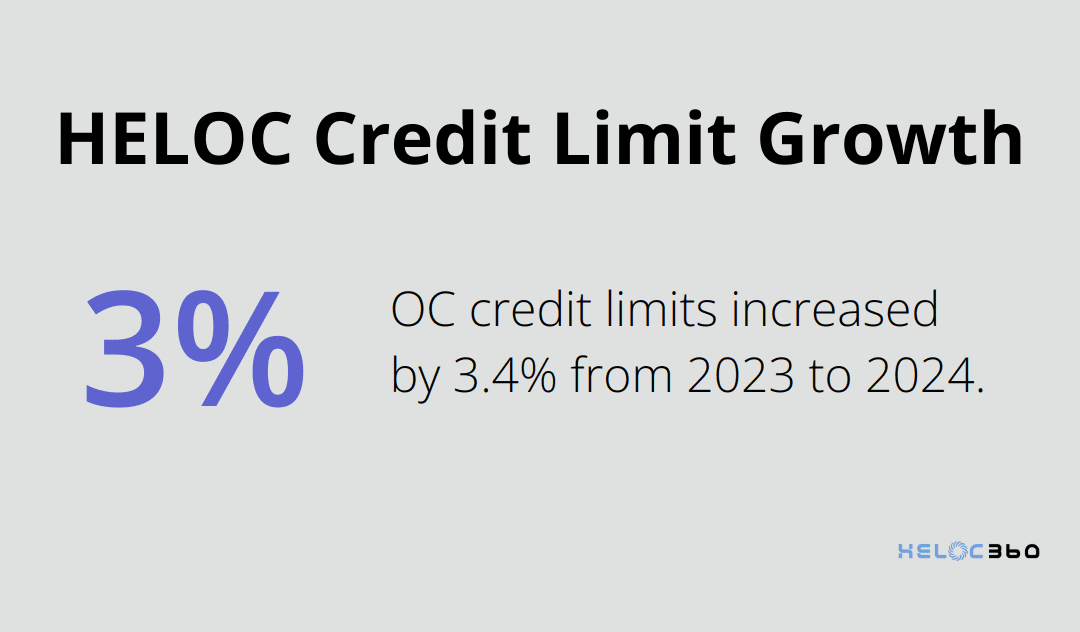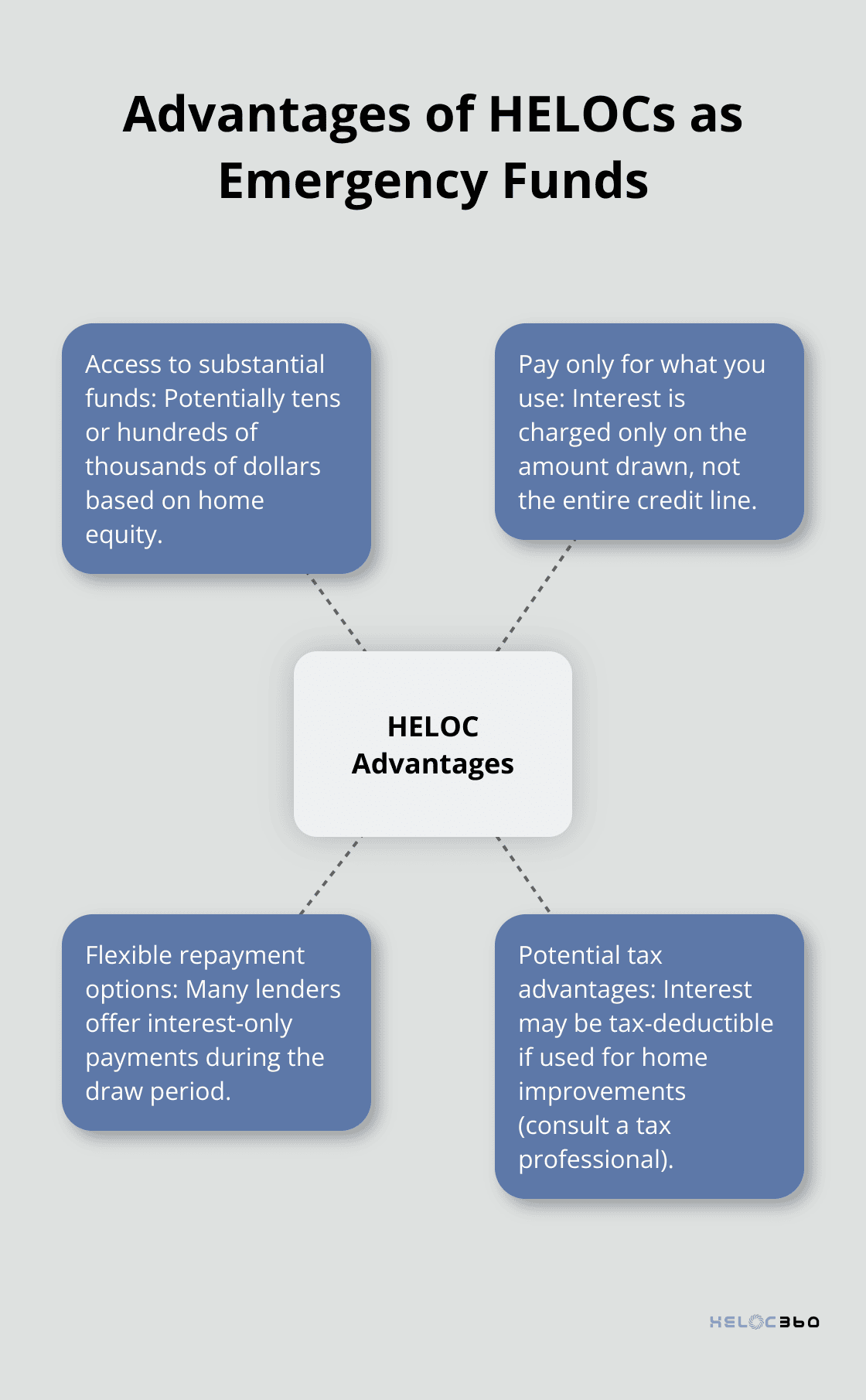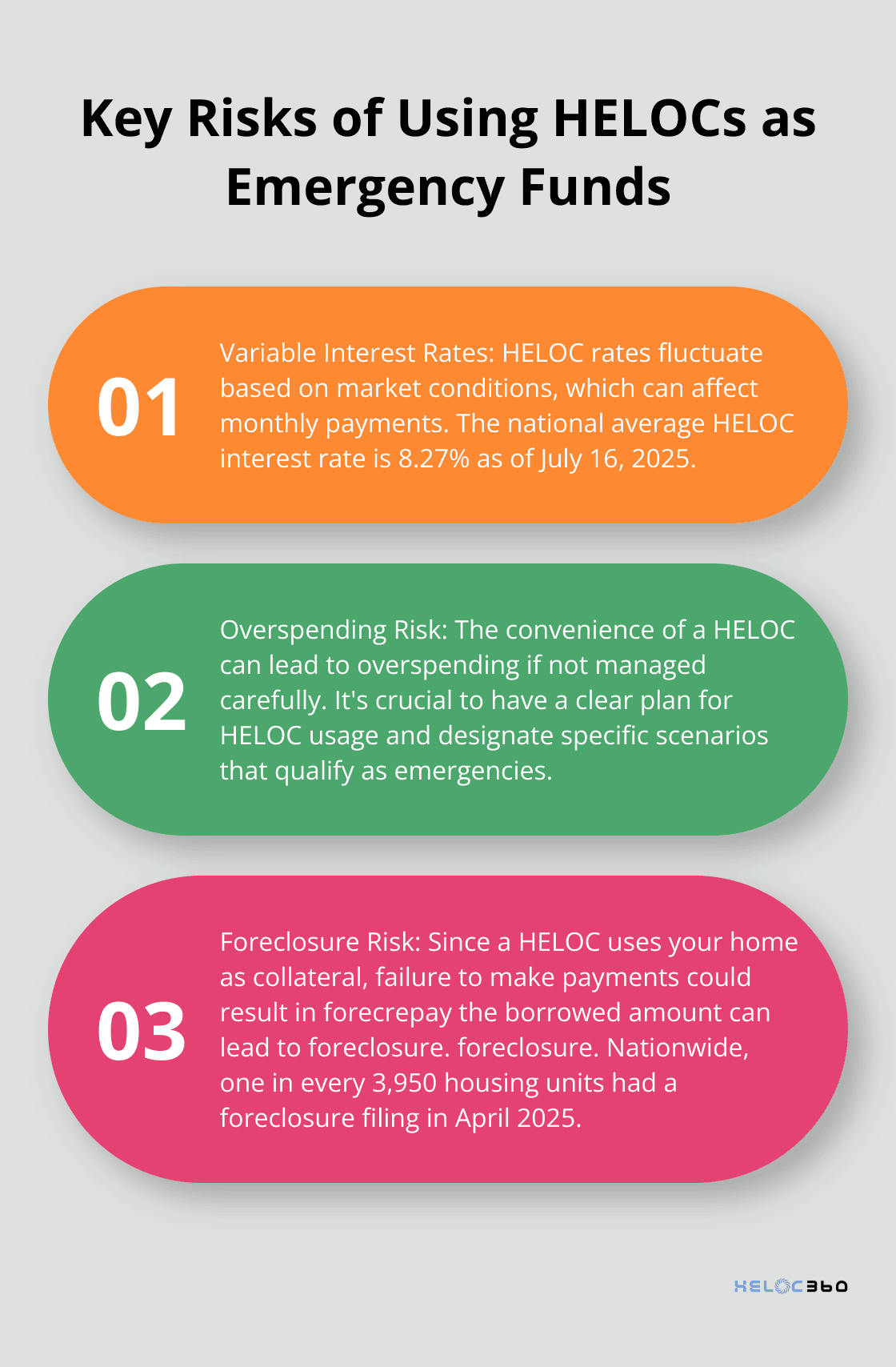When unexpected expenses hit, having a reliable emergency fund is crucial. But what if your home’s equity could serve as a powerful financial safety net? At HELOC360, we’ve seen how a Home Equity Line of Credit (HELOC) can be an effective alternative to traditional emergency savings.
Let’s explore why a HELOC emergency fund might be the perfect solution for your financial peace of mind.
What Is a HELOC and How Can It Serve as an Emergency Fund?
Understanding Home Equity Lines of Credit
A Home Equity Line of Credit (HELOC) is a line of credit secured by your home that gives you a revolving credit line to use for large expenses. Unlike traditional emergency funds (typically savings accounts with a set amount of cash), a HELOC provides access to a revolving credit line based on your home’s value.
The Mechanics of HELOCs
When you open a HELOC, you receive approval for a maximum credit limit. You can then draw from this line of credit as needed, similar to a credit card. The key difference? Your home serves as collateral, which often results in lower interest rates compared to unsecured loans or credit cards.
Leveraging HELOCs for Emergencies
One of the main advantages of using a HELOC as an emergency fund is the access to potentially larger amounts of money. While traditional emergency funds limit you to your savings, a HELOC can provide access to tens or even hundreds of thousands of dollars (depending on your home’s equity).
Cost-Effective Flexibility
Another benefit? HELOCs have the most flexibility in terms of how much you can borrow and when you can pay it off, compared with other home equity products. This means you’re not paying for funds you’re not using, which can be more cost-effective than keeping a large sum of money in a low-interest savings account.
For example, if you have a $50,000 HELOC but only need to use $5,000 for an emergency, you’ll only pay interest on that $5,000. This flexibility allows you to have a large safety net without the opportunity cost of having substantial funds sitting idle.
Potential Tax Advantages
It’s worth noting that in some cases, the interest paid on a HELOC may be tax-deductible if used for home improvements. While this doesn’t directly relate to emergency use, it’s an additional benefit to consider when setting up a HELOC. (Always consult with a tax professional to understand how this might apply to your situation.)
Many homeowners have successfully used HELOCs as a financial safety net. The key is to approach this strategy responsibly, understanding both its benefits and potential risks. Now, let’s explore the specific advantages of using a HELOC for emergencies in more detail.
Why HELOCs Excel as Emergency Funds
Access to Substantial Funds
HELOCs offer a unique advantage as emergency funds: access to larger amounts of money. While a typical savings account might hold a few thousand dollars, a HELOC can potentially provide access to tens or even hundreds of thousands, depending on your home’s equity. This means you’re better equipped to handle major unexpected expenses, like a new roof or extensive medical bills.
The average credit limit for HELOCs in 2024 was $121,613, which is 3.4% more than 2023’s average of $117,598. This substantial credit line can provide a robust safety net for various financial emergencies.

Pay Only for What You Use
Unlike traditional loans where you receive a lump sum and start paying interest immediately, HELOCs allow you to draw funds as needed. This means you only pay interest on the amount you’ve actually used. If you set up a $50,000 HELOC but only need to use $10,000 for an emergency, you’ll only pay interest on that $10,000. This feature makes HELOCs a cost-effective option for emergency funds.
Flexible Repayment Options
HELOCs typically offer flexible repayment terms, which can be particularly beneficial during financial emergencies. Many lenders provide interest-only payment options during the draw period. This flexibility allows you to manage your cash flow more effectively during challenging times.
For example, if you use your HELOC to cover unexpected medical expenses, you might opt for interest-only payments initially, giving you time to recover financially before tackling the principal.
Potential Tax Advantages
While not directly related to emergency use, it’s worth noting that interest paid on a HELOC may be tax-deductible if the funds are used for home improvements. The Tax Cuts and Jobs Act of 2017 allows homeowners to deduct the interest if you used the loan funds to buy, build, or substantially improve the home that secures the loan, for HELOCs taken out between 2017 and 2025.
This potential tax benefit adds another layer of financial advantage to using a HELOC, even if your primary intention is to have it as an emergency fund. (However, always consult with a tax professional to understand how this might apply to your specific situation.)

As we’ve seen, HELOCs offer several compelling advantages as emergency funds. But like any financial tool, they come with potential risks that you should understand before making a decision. Let’s explore these risks in the next section to give you a complete picture.
Understanding the Risks of HELOCs as Emergency Funds
Variable Interest Rates
One primary consideration when using a HELOC as an emergency fund is the variable interest rate. Unlike fixed-rate loans, HELOC rates fluctuate based on market conditions. The national average HELOC interest rate is 8.27% as of July 16, 2025, according to Bankrate’s latest survey of the nation’s largest home equity lenders.
For example, if you borrow $50,000 from your HELOC at 8.27% interest, your monthly interest-only payment would be about $344. However, if rates rise to 10%, that same payment increases to $417. This variability can affect your budget, especially during financial emergencies when cash flow might already be tight.
To mitigate this risk, you can set up automatic alerts with your lender to notify you of rate changes. Some lenders offer rate caps, which limit how high your rate can go. When exploring HELOC options, ask about these features to protect yourself from dramatic rate increases.
Easy Access and Overspending
The convenience of a HELOC can be a double-edged sword. While it provides quick access to funds during emergencies, it can also lead to overspending if not managed carefully. An Urban Institute study found that HELOCs in particular require pristine credit – about 45 percent of YTD 2022 HELOC originations had credit scores over 780.
To avoid this pitfall, create a clear plan for your HELOC usage. Designate specific scenarios that qualify as emergencies (such as unexpected medical bills or critical home repairs). Consider setting up a separate account for your HELOC funds to make tracking easier and reduce the temptation to use it for non-emergencies.
Foreclosure Risk
It’s important to note that a HELOC uses your home as collateral. If you fail to make payments or are unable to repay the borrowed amount, you risk foreclosure. According to RealtyTrac data, nationwide one in every 3,950 housing units had a foreclosure filing in April 2025.
To minimize this risk, carefully assess your ability to repay before drawing from your HELOC. Create a realistic budget that accounts for potential rate increases and changes in your income. If you face financial difficulties, communicate with your lender early. Many lenders offer hardship programs or modified payment plans to help borrowers avoid default.
Credit Score Impact
Your credit score can be affected by how you use your HELOC. Opening a HELOC may cause a temporary dip in your credit score due to the hard inquiry and new account. However, responsible use can positively impact your score over time.
FICO reports that credit utilization accounts for 30% of your credit score. Try to keep your HELOC balance below 30% of your credit limit to maintain a healthy credit utilization ratio. Regular, on-time payments are essential, as payment history makes up 35% of your FICO score.
Monitor your credit report regularly to ensure your HELOC usage is reported accurately. Many credit card companies and banks offer free credit score monitoring, which can help you stay on top of any changes.

Final Thoughts
HELOCs offer a powerful alternative to traditional emergency funds. They provide homeowners with access to substantial amounts of money, flexible repayment options, and potential tax advantages. The ability to tap into your home’s equity can provide a robust financial safety net, allowing you to handle unexpected expenses with greater ease and confidence.
A HELOC emergency fund requires caution and responsibility. Variable interest rates, risk of overspending, and potential for foreclosure underscore the need for careful planning and disciplined use. Before establishing a HELOC emergency fund, you should assess your financial situation, create a clear plan for its use, and ensure you have a solid strategy for repayment.
HELOC360 offers a comprehensive platform to help you navigate the process. Our expert guidance and tailored solutions can help you unlock the full potential of your home equity while minimizing risks. We connect you with lenders that fit your unique needs, empowering you to make informed decisions about your financial future.
Our advise is based on experience in the mortgage industry and we are dedicated to helping you achieve your goal of owning a home. We may receive compensation from partner banks when you view mortgage rates listed on our website.
